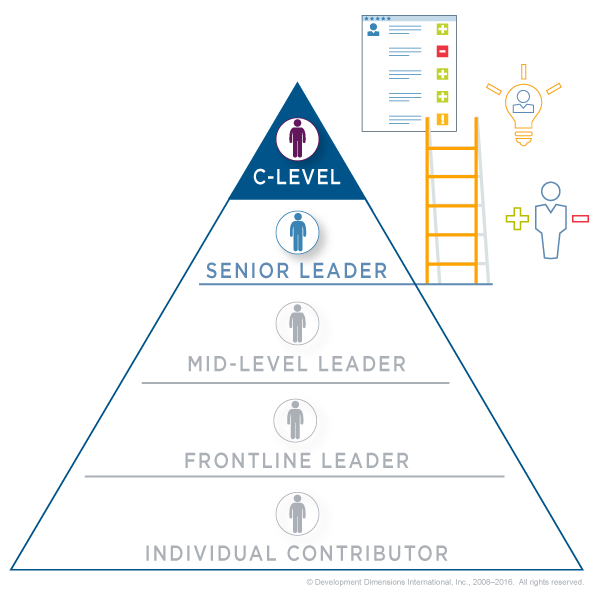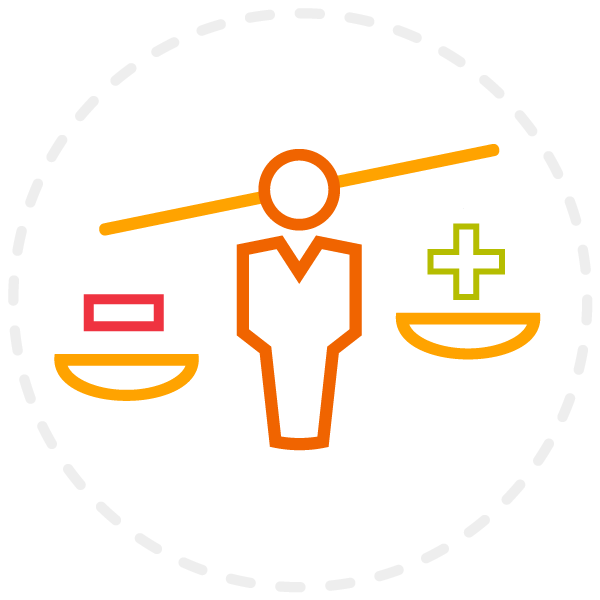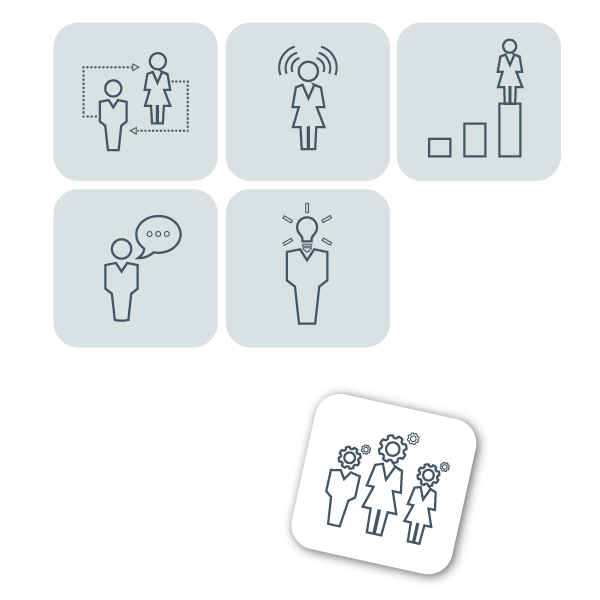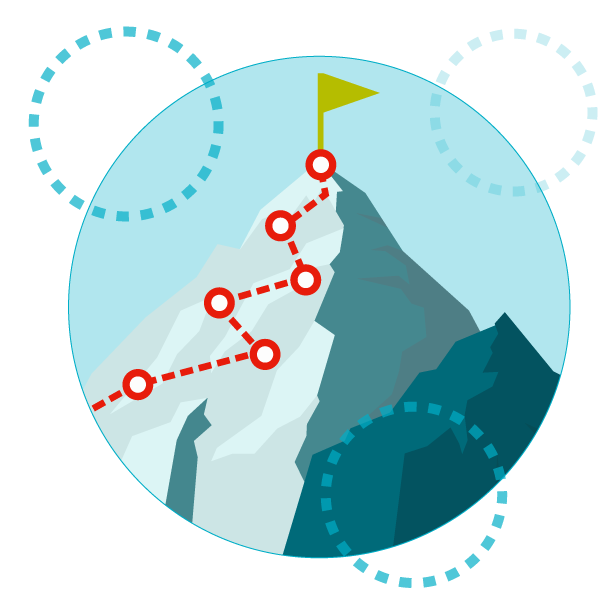C-Suite Assessment
The Data You Need for Your Highest Risk Decisions
Deciding who to put in the C-suite – and CEO – is the highest risk decisions your company will make. So you need to be sure about your decision. And you need to be able to defend them to the company, board, and shareholders.
So, to make talent decisions at the top, you need one thing: objective data. Fortunately, DDI's C-suite assessment offers the most robust, objective data on the market.
How does an immersive C-suite assessment work?
An immersive C-suite assessment is a realistic, day-in-the-life experience that puts executives in the shoes of a CEO or other C-suite executive at a fictional company.
In the role, they face the complex challenges facing today’s C-suite. For example, they may have to:
- create a motivational vision for the company,
- respond to a journalist’s interview,
- develop a business strategy, or
- partner with an executive from an outside organization.
Meanwhile, a team of trained assessors analyze how the executive performs key behaviors. After the simulation, the executive and stakeholders receive a detailed report about the executive’s strengths and weaknesses.

We had a pretty good view about the knowledge, experiences, and personal attributes of our candidates, but when asked, ‘What are they capable of?’ that’s where we really needed DDI’s insight.
— -Bill Lambert, Non-Executive Chairman and former CEO, MSA Safety Inc.
Why Should I Use an Immersive C-Suite Assessment?
We’ve spent decades research the best methodologies for C-suite assessment. And there’s a reason we use our pioneering assessment center model: It’s the most accurate.
There’s no better way to predict how someone is likely to perform on the job than to simply let them do it.
This high-fidelity data gives you and your board:
- True objectivity and less bias in your C-suite decisions.
- Insights into what you can’t observe from past performance alone.
- Benchmarking data against the executive talent market.
- Prediction of future performance.
- The ability to play out business scenarios.


When is an immersive C-suite assessment the right fit?
While every situation is unique, here are a few ways our clients use the data from a C-suite assessment:
- Identify and develop successors for CEO and other C-suite roles
- Make final selection decisions between similar candidates for C-suite roles
- Determine whether internal candidates are prepared for key roles, or they need to look externally
- Create a targeted development plan for new C-suite members
- Compare internal and external candidates fairly

Featured Client Story
Seeing the Next CEO at an Integrated Healthcare Organization
How a regional healthcare system identified its next CEO.
ReadWhat does the executive get out of it?
We’ll be honest: A C-suite assessment is an intense experience. And it should be, because these are intense jobs.
But at heart, this is about finding a moment of truth before an executive takes on the biggest challenge of their career.
For many of our clients, the C-suite assessment is their first chance to see whether they really want the role they are aiming for. And if they do, they get the honest and objective feedback they need to develop themselves so they can get where they want to go.
In fact, the vast majority of our business comes from referrals of CEOs and board members who went through the experience in the past. It was so memorable and pivotal to their development that they demand it for the next generation of successors.


What does a C-suite assessment measure?
DDI’s C-suite assessment creates a holistic view of an executive, including personality, skills, and experience. While the simulation is at the heart of the experience, we combine it with personality inventories and interviews to create a full picture of the person’s capabilities.
This approach helps you answer three key questions:
- Does the person have the capability and motivation to succeed in a specific role?
- How does the person’s capabilities compare to other executives?
- If they are chosen for the role, where do they need to focus their development to excel?
Learn More in Our Webinars on C-suite Succession

Learn the anatomy of a healthy board approach to C-suite succession, and where boards go wrong in choosing successors. You'll also see the tools boards can use to manage the process.
WEBINAR
C-suite Succession Planning

Too often, high-flying successors stumble. And when they do, boards are taken by surprise. Learn how to frame expectations for growth and adopt a healthy risk profile in development.
WEBINAR
How Successors Struggle on the Way to the C-suite

There's a better way to grow executives than trial by fire. In this webinar, we cover the five critical things that boards of directors and CEOs most often overlook as they develop C-suite executives.
WEBINAR
C-Suite Development
Can I customize the assessment to any C-suite role?
Every C-suite role has a different set of demands. Before we begin the process, we work with you to create a success profile of the exact skills required for the role.
In addition, we customize the assessment against the specific challenges and context of your business. Because we know that what made your last CEO successful may not be what you need in your next CEO.
In short – we make this experience about the specific context of the role and your business.


How does a C-suite assessment ensure success once the executive is in the role?
No one is perfect. But in our experience, executives who come into C-suite roles with a strong awareness of their strengths and weaknesses have much smoother transitions.
CXOs can use the data to quickly target their development in the areas that will make the most impact for their success.
Furthermore, this strong self-awareness can help them to choose and develop a team of people around them who can help fill their gaps.
Learn more about our C-suite simulation
Have a Question?
Frequently Asked Questions About C-Suite Assessment
-
How can C-suite assessments help us choose the right executives?
C-suite assessments provide the objective data you need to make your highest-risk talent decisions with confidence. By placing executives in realistic business scenarios, you get deep insight into how they lead—helping you better predict success and select leaders who can deliver real impact.
-
What is different about DDI’s approach to assessing C-suite leaders?
Our immersive assessments are tailored to the specific role and your business context. Executives face complex, realistic challenges while trained assessors evaluate key behaviors. This approach creates a clear picture of readiness, potential risks, and development needs tied to your strategic goals.
-
When should we use a C-suite assessment in succession or hiring?
Use C-suite assessments throughout the succession and hiring process, from identifying successors and comparing candidates to development after placement. Whether you’re weighing internal vs. external options or supporting a newly promoted executive, assessments guide fair, informed decisions and accelerate onboarding success.
-
What skills can executive assessments measure?
C-suite assessments measure more than just skills. They create a complete picture of a leader’s capability, including personality, experience, and motivation. This information helps you understand how an executive compares to their peers, whether they are ready for a role, and how to support their growth once they step into it.
recommended Resources
-
Learn how one company worked with DDI to form a plan for developing a COO for CEO succession.
CLIENT STORYHow We Did It: Developing a COO for CEO Succession
21 min
-
As an executive coach, I spend much of my time coaching executives who are transitioning into the CEO role. Here are five things I've learned that lead to new CEO success.
BLOG5 Tips for New CEO Success
5 min
-
Where do boards go wrong when it comes to C-suite leadership development? Learn the most common mistakes and how to ensure you have leaders ready for your top positions.
BLOGFive Mistakes Boards Make in C-Suite Leadership Development
13 min
